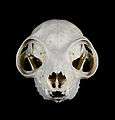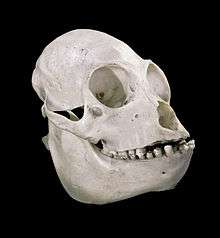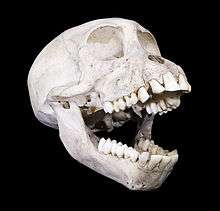Muséum de Toulouse
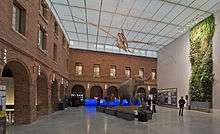
43°35′37.89″N 1°26′57.42″E / 43.5938583°N 1.4492833°E
The Muséum de Toulouse, sometimes known as MHNT or Muséum d'Histoire Naturelle de la ville de Toulouse, is a museum of natural history in Toulouse, France. It is located in the Busca-Montplaisir, and houses a collection of more than 2.5 million items.
History
The museum was founded in 1796 by the naturalist Philippe-Isidore Picot de Lapeyrouse. It was at that time housed in the old buildings of the monastery of the carmelite friars. It was opened to the public in 1865 in its present location and under the directorship of Édouard Filhol. Toulouse museum was the first museum in the world to open a gallery of prehistory, thanks to the collaboration of Émile Cartailhac, Jean-Baptiste Noulet and Eugène Trutat. Today the museum is housed in a 2007 building designed by the architect Jean-Paul Viguier.
Permanent exhibitions
The permanent exhibition has 5 linked themes:
- Sequence 1: Feeling the Earth's power.
Nature of the solar system and its formation. Nature of the Earth - plate tectonics, seismic and volcanic activity and erosion, petrology and mineralogy.
- Sequence 2: Doing away with our notions of hierarchy
The nature of life - biodiversity, classification and organization.
- Sequence 3: Getting to grips with the huge scale.
Earth history from 3.8 billion years ago. Introduces time, palaeontology and the evolution of life
- Sequence 4: Admitting the obvious
The main functions of living beings - feeding, respiration, locomotion, reproduction, protection and communication.
- Sequence 5: Inventing the future.
The impact of human activity- demographic pressure on ecosystems and natural resources
Collections
In this section, we present examples to illustrate the content of each different collection of the Museum de Toulouse.
Prehistory
The prehistoric collection includes mostly artefacts excavated in France. They also contain comparative material from other parts of Europe and other continents. Notable collectors include Édouard Harlé (1850–1922), Antoine Meillet (1866- 1936), Alexis Damour (1808–1902), Félix Regnault (1847-1908), Louis Péringuey (1855-1924), Émile Cartailhac (1845-1921), Daniel Bugnicourt, Edward John Dunn (1844-1937), Henri Breuil (1877-1961) and Louis Lartet (1840–1899) as well as the curators Jean-Baptiste Noulet (1802-1890), Eugène Trutat (1840 -1910) and Édouard Filhol (1814-1883).

Mesolithic tomb from Téviec, Brittany 
Polished Neolithic axes from Reims France – Alexis Damour collection 
Polished Neolithic axes from Plagne Haute-Garonne collection Félix Régnault collection 
Bronze bead necklace Holocene Bronze age Jean-Baptiste Noulet collection
Botany
- The herbarium contains historic specimens collected by Benjamin Balansa (1825-1891).

Entada phaseoloides – Fruit 
Luffa aegyptiaca – Fibrous skeleton 
Cassia fistula – Ripe fruit
Entomology
Coleoptera
.jpg)
Cerapterus pilipennis - Zambia 
Chrysochroa rajah thailandica - Chiang Mai, Thailand 
Hiperantha testacea
Bupestrid from Colombia
Metaxymorpha gloriosa Bupestrid from North Queensland, Australia
Lepidoptera

Historis odius - Colombia .jpg)
Charaxes varanes vologeses - Malawi 
Morpho didius - Peru 
Archaeoprepona licomedes - Brazil
Orthoptera
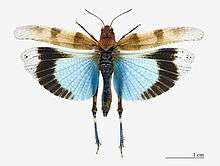
Oedipoda caerulescens - Etang de la Maourine Toulouse 
Titanacris Albipes- French Guyana 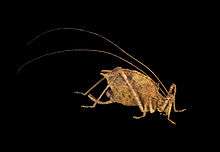
Porphyromma speciosa-French Guyana
Mineralogy

Celestine - Turkmenistan 
Fluorite - France 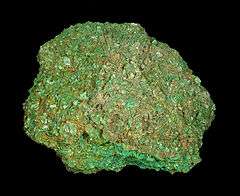
Nepouite - New Caledonia .jpg)
Scheelite - China 
Sphalerite - Roumania
Ornithology
- The bird collection of MHNT contains more than 30,000 specimens of which 20,000 are eggs. There are approximately 8,500 bird mounts and 1,500 scientific bird skins. Other bird items are circa 2,000 skeletons and skulls and 5,300 eggs. The collection focuses on Europe (especially France), but there are also exotic species. Most are documented on card or computer system.
- The bird mount collection of Victor Besaucèle with 5,000 specimens is one of the most important historic collections in Europe.
- Other collectors represented are R. Bourret, G. Cossaune, M. Gourdon, Hammonville, A. Lacroix and Reboussin

Snowy owl. The oldest mount in the museum, collected by Mr Dode in 1807 
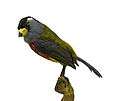
- The egg collection of Jacques Perrin de Brichambaut (1920–2007) was acquired in 2010. It contains his personal collections, supplemented by those of other ornithologists notably Georges Guichard, Henri Heim de Balsac and Rene de Naurois. It includes all the palearctic species (Europe, North Africa and Asia), that is to say approximately 1,000 species and nearly 15,000 eggs and is one of the most complete and best documented palearctic egg collections in Europe.
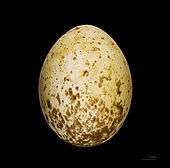 Egg of wedge-tailed eagle
Egg of wedge-tailed eagle Egg of little egret
Egg of little egret Egg of helmeted guineafowl
Egg of helmeted guineafowl Egg of southern giant petrel
Egg of southern giant petrel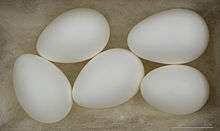 Nest of common house martin
Nest of common house martin
Osteology
Paleontology
The specimens of the collection of paleontology amount to tens of thousands. They date from the Paleoarchean to the Eocene.
Invertebrates

One of the oldest life forms, a Stromatolite of Paleoarchean age – 3, 600 to 3, 200 Ma (million years ago) 
Trilobite of Middle Ordovician – 468 to 460 Ma (million years ago)
Vertebrates
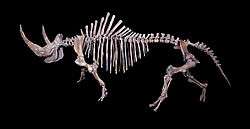
Woolly rhinoceros complete skeleton of Pleistocene age – 370, 000 to 10, 000 years ago 
Woolly rhinoceros, complete skull 
Cave bear mandible of Pleistocene age
The Henri Gaussen Botanical Garden
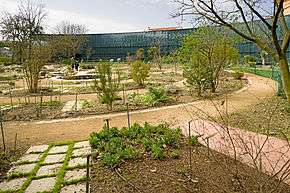
Henri Gaussen was a Toulouse-based phytogeographer and botanist. The botanic garden which honours his name is attached to the Museum and is part of the Earth and Life Science Research and Training Paul Sabatier University. A second botanical area The Museum Gardens extends over 3 hectares. It is notable for "potagers du monde" (vegetable gardens of the world) and a shade house which recreates the conditions required by shade plants.
References
- Part of this article is a translation of (or greatly inspired by) the French Wikipedia's article (see the list of authors)
- François Bon, Sébastien Dubois, Marie-Dominique Labails, 2010. Le Muséum de Toulouse et l'invention de la préhistoire Toulouse Editions Muséum de Toulouse ISBN 978-2-906702-18-9
External links
| Wikimedia Commons has media related to Muséum de Toulouse. |









